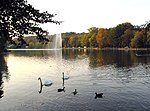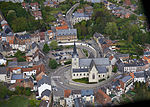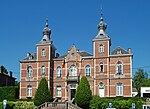Rixensart

Rixensart (French pronunciation: [ʁiksɑ̃saʁ] ; Walloon: Ricsinsåt) is a municipality of Wallonia located in the Belgian province of Walloon Brabant. On January 1, 2018, Rixensart had a total population of 22,401. The total area is 17.54 km2 which gives a population density of 1,277 inhabitants per km2. The municipality consists of the following former municipalities, now districts: Rixensart, Rosières, and Genval. Genval-les-Bains is a local beauty spot, a 100-year-old lake with a fountain, and framed by trees, houses and restaurants. Rixensart is home to the beautiful private-owned Château de Rixensart. Rixensart is served by two railway stations (at Rixensart and at Genval), connecting it with Brussels to the north and Louvain-la-Neuve to the south. The new arrival of the Brussels RER, will improve both train stations and upgrade the number of trains going from Brussels to Namur to 4 per hour. This will also bring more people to the municipality to live. The municipality is now classified as a commuter town due to its proximity to Brussels, the RER and the E411 Motorway.
Excerpt from the Wikipedia article Rixensart (License: CC BY-SA 3.0, Authors, Images).Rixensart
Avenue Legrand,
Geographical coordinates (GPS) Address Nearby Places Show on map
Geographical coordinates (GPS)
| Latitude | Longitude |
|---|---|
| N 50.716666666667 ° | E 4.5333333333333 ° |
Address
Avenue Legrand 11
1330 (Rixensart)
Walloon Brabant, Belgium
Open on Google Maps










